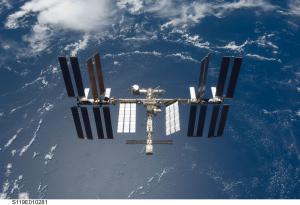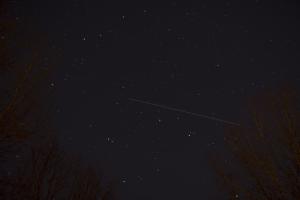
Stargazing Nights
- Where:
- Frosty Drew Observatory
- When:
- Friday February 8, 2019 at 7:00 p.m
- Cost:
- $5 Suggested Donation per person 5 years and older
Tonight is Stargazing Night at Frosty Drew Observatory and forecasts are looking fantastic! For a third Friday consecutively, we’re setup for beautifully clear skies with little to no Moon present. Though tonight’s Moon, which will set at 8:47 pm, will be in a stunning 14% waxing crescent phase, hanging softly over the WSW horizon, with Earthshine glowing brightly. Earthshine is when we see the nighttime side of the Moon alongside the illuminated crescent, this happens due to sunlight reflecting off Earth and onto the night side of the Moon. The only gripe we have with tonight’s weather is the coming wind. Over the course of our geek out, winds will increase quickly into the 20 mph range, with gusts that could blast into the 40 mph range. This may create problems for our viewing. Though we will make a best effort attempt at dealing with the wind. It’s important to note that the previous two Fridays were forecast to have some wind, which never happened.
We will open the Observatory and Sky Theatre at 7:00 pm tonight. In the Observatory, telescopes will start off with views of the sexy 14% crescent Moon. As the Moon sets and the darkness prevails, we will direct our telescopes towards numerous objects only visible on the darkest nights, including the Orion Nebula, R-lepus carbon star (the Vampire Star), the Eskimo Nebula, NGC 2359 – a Wolf-Rayet star, Messier 46 open star cluster, the Ghost of Jupiter, and more. In the Sky Theatre, temps will be warm, and onscreen we will show our regular feature of celestial objects photographed at Frosty Drew Observatory. We will close up at 11:00 pm unless the wind shuts us down early. Following us on Twitter (@FrostyDrewOBSY) or checking in on the right column of our website will get you updates from the Observatory on what we are seeing, including a “Closing up” post when we decide to start packing up.
Overall, tonight is another fabulous night to be out at Frosty Drew Observatory. Clear skies, a fabulous crescent Moon, and super dark skies are all the right parts of an amazing night. The wind will be the variable factor in how amazing tonight will be, with a likelihood that it will be quite windy. This could restrict our viewing to only one side of the sky. Though the starscape will be one you can get lost in. So bundle up and set out to the darkest spot in Rhode Island for a night out with the cosmos.
--------------------------
Weekly Happenings
Scott MacNeill
Those who live in locations dark enough to observe the Milky Way, or those who frequently visit Frosty Drew Observatory on dark nights, have certainly noticed that the Milky Way we see in the wintertime differs significantly than what we see during the summertime. This is all about how the nighttime side of Earth orientates with the galaxy. In the mid spring – mid autumn months, the nighttime side of Earth is orientated, generally, towards the center of the galaxy, with the beginning of July being the time when the the night side of Earth is directly facing the galactic nucleus. This allows us to see the combined starlight of billions of stars along numerous galactic arms, silhouetted by large regions of dark interstellar dust (dust lanes). During the winter months, Earth’s nighttime sky is orientated away from the center of the galaxy, facing the outer edge of our galactic hemisphere. At this vantage point, only the Perseus Arm of the galaxy is visible, silhouetted against dark space beyond. This gives us a significantly dimmer view of the Milky Way in the winter months, a view that is rather featureless (at first glance) than the summertime view. For those of you who are obsessed with that summertime view of the Milky Way galactic nucleus, you can catch an early morning preview right now. Especially if you live along the East Coast or along the Great Plains. Set out about 1.5 hours before sunrise and look to the SE to catch a view of the galactic nucleus rising with pre-dawn. Here is a beautiful capture of exactly that by James Crouch at East Beach, directly south of Frosty Drew Observatory, this past Wednesday morning. At Frosty Drew Observatory, we don’t start our summertime Milky Way viewing until April, though some of the Milky Way crazies in the area (like James) will not take the back seat waiting for the comfort of a late-April morning.
Alongside three weeks of clear Friday’s, we are also entering our third week of International Space Station (ISS) passes over the Northeast evening skies, with the best pass of the week happening tonight. Here are some notable passes of the ISS for the coming nights:
Fri, Feb 8 at 6:01 pm, starting in the NW, rising nearly overhead, then setting in the ESE. This is the pass to see!
Sat, Feb 9 at 6:47 pm, starting in the W, rising to 22°, heading towards the S
Sun, Feb 10 at 5:55 pm, starting in the WNW, rising to 40°, heading towards the SSE.
Tue, Feb 12 at 5:49 pm, starting in the W, rising to 17°, heading towards the S.
These are the last evening passes over our region until the ISS returns on March 20, 2019. Times listed are for Southern New England, and are generally acceptable for the Northeast. For pass times applicable to your location, visit NASAs Spot the Station. Now put these times on your calendar, and step out for a view of humanity’s only space based residence zooming by.
While wrapping up a rather long bout of fabulous evening ISS passes, keep in mind that China’s Tiangong 2 space station is commencing evening passes over the US. Though not as bright at the ISS, Tiangong 2 is easily visible as it passes over our region. Here a list of excellent passes over the Northeast this coming week:
Sat, Feb 9 at 7:00 pm, starting in the WSW, rising to 49°, entering Earth’s shadow over the SW
Sun, Feb 10 at 6:01 pm, starting in the SW, rising to 42°, heading towards the E
Mon, Feb 11 at 6:39 pm, starting in the WSW, rising 87°, entering Earth’s shadow at 54° over the ENE
Tues, Feb 12 at 7:16 pm, starting in the W, rising to 35°, entering Earth’s shadow over the WNW
Wed, Feb 13 at 6:17 pm, starting in the W, rising to 70°, entering Earth’s shadow at 23° over the ENE
Thur, Feb 14 at 6:55 pm, starting in the W, rising to 67°, entering Earth’s shadow over the N
Unlike the ISS, Tiangong 2 is not continuously inhabited and only hosts human occupants occasionally. Daily passes of Tiangong 2 will continue until February 21, 2019, offering up another set of fabulous satellite viewing opportunities.
-Scott



